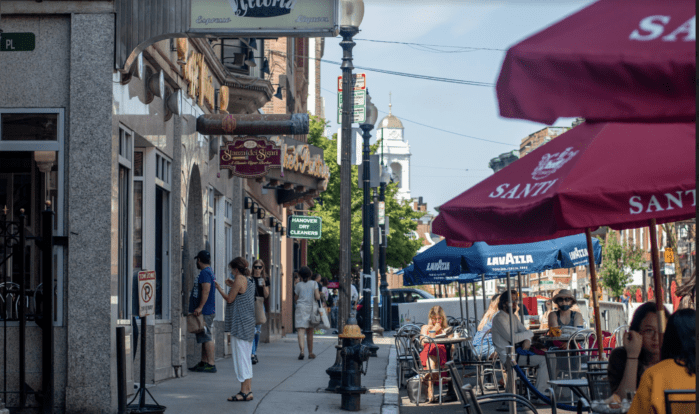
When it comes to local dining spots, what you see is what you get for the foreseeable future.
With Phase 2 now firmly in place, restaurants in the Boston area and elsewhere in Massachusetts have been able to open outdoor dining areas and, more recently, indoor dining sections, each of which has restrictions based on COVID-19 regulations. As we move further and further into the phases to reopen the state economy, this means that local restaurants will continue to progress toward a “new normal” over the coming weeks where their capacity starts approaching the prepandemic days, right?
Wrong.
While dining spots in the state have certainly come a long way from only being able to offer takeout and delivery during the initial restaurant shutdown and Phase 1, what we are in now appears to be the new normal, not Phase 4, which is slated to commence only when vaccines and/or treatments for the virus are available, meaning that phase might not happen until next year at the earliest. And because Phase 3 has little in it that affects restaurants one way or another, we are now stuck in what is basically a holding pattern for dining spots where, sadly, there may be no place to go but back (which might happen if new outbreaks, spikes, or surges develop) for the foreseeable future.
Because we are now in a static period for restaurants, it may be worth looking at the options currently available for diners, which include takeout, curbside pickup, delivery, outdoor dining, and indoor dining. Takeout is, well, takeout, and it’s a well-established option whose familiarity makes it suitable for many diners, especially in the case of places such as sub shops, pizzerias, late-night Chinese-American eateries, roadside drive-ins, and seafood shacks, all of which are basically designed for takeout. The problem is, takeout often doesn’t work as well for other types of places such as high-end restaurants, mid-level family-friendly chains, sushi bars, Irish pubs, and others, so it really isn’t a be-all and end-all for the restaurant industry in general. Curbside pickup—which is an offshoot of takeout—is a more recent setup where diners go to a restaurant and pick up their takeout food outside of the dining spot. In some ways, this has been the ideal option during the pandemic because it is often contactless and doesn’t have the added step (and potential exposure issue) of delivery.
Now that restaurants have reopened their indoor dining areas, though, some places have done away with curbside pickup and only have takeout where customers have to go inside to get their food, which is a big problem for those who don’t want to have contact with strangers. In addition, neither takeout nor curbside pickup results in the extra rounds of drinks, extra appetizers, or spur-of-the-moment desserts that so often happen inside dining rooms or lounge areas, so restaurants ultimately lose at least some income with these options (not to mention lower or even no tips for workers).
Delivery was an increasingly popular option before the pandemic, and it certainly took off once the coronavirus led to restaurants having to shut down their dining areas, especially because the contactless option for delivery (where online or phone orders are dropped off outside your door) is about as safe and easy as curbside pickup. But as is the case with takeout and curbside, delivery doesn’t allow for ordering extra food or drink since diners are not actually at the restaurants, so once again, restaurants don’t do as well with this option while workers don’t get as much in the way of tips.
Also, third-party delivery services can really hurt restaurants via high fees while the restaurants themselves aren’t able to build relationships with customers, which may seem like a trivial thing, but when you’re a regular customer at a small, independent eatery, that bond can be critical to a restaurant’s success. Finally, if delivery isn’t contactless, there’s always the risk of transmission of the virus, though more and more, delivery is contactless these days.
To many, socially distanced outdoor dining has the true feel of the “new normal,” as it is relatively safe (if all the guidelines are followed by both restaurants and diners); it allows customers to physically be at the restaurants themselves, which allows for extra purchases of apps, drinks, desserts, etc.; and when it comes to exposure to the virus, being outside tends to be safer than being inside. But once you look deeper into al fresco dining, you can see some serious problems with it, including the simple fact that not every restaurant can offer it.
Sure, cities and towns in the Boston area and elsewhere seem to be doing whatever they can to help restaurants create new patios or expand existing ones, but if you are a dining spot with a narrow sidewalk and a two-lane road out front and no parking lot in the back, outdoor dining may not be a viable option.
And, of course, there is the issue of weather, as an extended rainy period can dash the hopes of outdoor dining except in the case of covered patios, and then there is the simple fact that the summer doesn’t last forever. Will heat lamps keep diners warm on a windy 10-degree night in December? Unless you’re a penguin (or have a really puffy coat), that probably won’t be happening.
This brings us to indoor dining, which, while recently introduced, still doesn’t feel “right” to some customers, and also to some restaurant owners and workers as well. Indoor dining and bar areas (whose bar tops could remain off limits until Phase 4) are where the real money is, as in normal times they are always available no matter what the weather is outside and they allow people to keep ordering food and drink from start to finish.
But with the virus still lurking, indoor dining feels more risky than the other options, especially considering the airflow in interior spaces and how that could play a role in spreading the virus (think about how air conditioning and ceiling fans work, for instance). To put it simply, there is a not-so-small chunk of the population that will simply not dine indoors for at least the time being, and there isn’t a whole lot that restaurant owners can do to convince them that it’s safe to do so.
So what does this all mean to the restaurant industry? It depends on what segment of the business you are in, of course, as seasonal snack shacks and sandwich shops will generally continue puttering along as always, while small higher-end restaurants with no space for outdoor dining may literally need to reconcept in order to survive. But the bottom line is, Phase 2 is in some ways the final phase for now, which means that very little will change until a medical breakthrough becomes reality. The “new normal” is anything but normal, but it’s all we’ve got right now, so for many restaurants—and customers—it’s all about adjusting and playing a waiting game that could last for awhile.
This article was produced in collaboration with the Boston Institute for Nonprofit Journalism as part of its Pandemic Democracy Project.
HELP DIGBOSTON WEATHER THIS STORM AND CONTINUE PROVIDING ARTICLES LIKE THIS ONE
Marc is the founder of @hiddenboston, a textbook editor, a hike leader for @AppMtnClub, and a food and travel writer and commenter for DigBoston, NBC/NECN, WBZ, WMFO and indie617.

